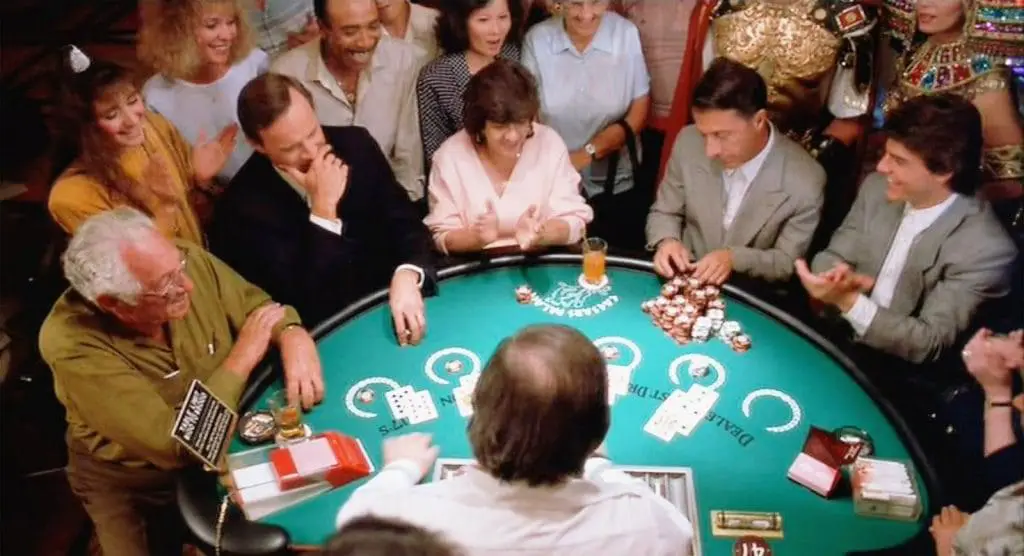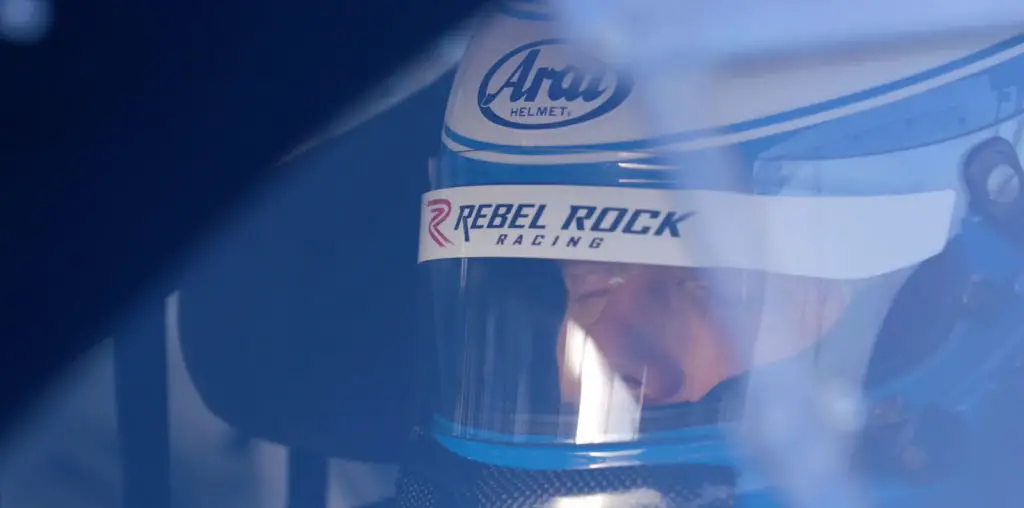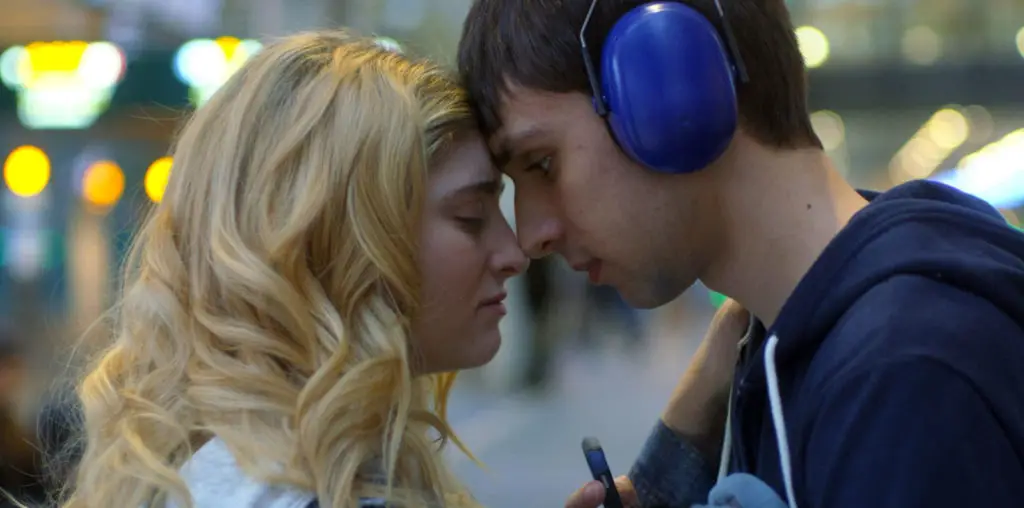
A bleak office scene. A young man struggling amid his dreary job. It’s his birthday, but he’s so caught up in the blue-tinged lights, the gray work, and the humming of the machine in front of him to even notice when his best friend comes in. It’s his birthday, and his friends are going to show him the time of his life in the desert (the Mojave desert just outside of Los Angeles) with some mescaline, a rave, and his best buds. The young man decides to throw in the towel and have a blast. After all, the work will still be there on Monday. So begins the buddy-film-turned-nightmare that is “Mojave”. A cross between “Deliverance” and “Breakdown”, this first time filmmaking effort is astonishingly polished and gracefully executed, though oft predictable, repetitive, and slightly overdone.
The time-lapse footage created by Zachary Boggs gives “Mojave” some of the most interesting opening credits in a film I’ve ever seen, creating the fast-paced, anthill lifestyle of Los Angeles. The landscape scenes, shot by cinematographer Tom Harting, are breathtaking, and the desert was exploited to its full potential to show the desolation, distress, and yet wild beauty of the environment the friends find themselves trapped in throughout the stretch of the film. The directing takes on an almost Robert Rodriguez style at times, especially when a story is being told within the story. If Rodriguez hadn’t done it first, I’d say this was a very innovative and intriguing approach to storytelling. Unfortunately for the creators of “Mojave”, it’s been done before, but it still looks good. The direction and cinematography also reveal some beautiful camerawork during some nerve-racking bad trips on the mescaline. The most impressive, however, is a fighting scene that utilizes shadow and light to show the confrontation in a new way. No gore and blood is necessary when the camera is so beautifully maneuvered to catch each movement in the shadow across a desert rock; the result is still spine tingling. The musical score by Nathan Barr is so like “Once Upon A Time in the West” that I swear it was “inspired by.” It works well for the desert setting and for the serious showdowns that take place between bad guys and good guys.
If technically the film was executed so well, it can only be in the predictable storyline and cliché relationships between friends and enemies during times of intense crisis that the downfall arrives.
Four friends on a trip out in the wilderness come across some vicious hicks who resort to rape, violence, and hysterical laughter to intimidate the outsiders. Sound familiar? If you said “Deliverance”, you’re right. It’s basically the same plot in a nutshell. Except this time we’re in the desert. And this time there is a girl. The whole “My name is Zeke and we don’t like you fancy city folks acomin’ and ruinin’ our pristine wilderness” is an old plot that has facilitated not only “Deliverance” but “Texas Chainsaw Massacre”, “Wrong Turn”, “Spider Baby”, “The Hills Have Eyes”, Just Before Dawn”, “Motel Hell”, “House of 1000 Corpses”…The list goes on and on. It’s the old idea that we fear the strangeness of those who choose to live in solitude, away from the city and away from change. We see them as a threat, as territorial, and as terrifying creatures that are the products of inbreeding and abuse. Is this just one more motif explored to excess by horror and thriller films like slashers, urban legends, and the supernatural? You bet. It’s fun to make fun of hicks though, so it keeps working. It even works in “Mojave”, it’s just getting old.
The acting is great, but the dialogue is over the top. There are at least two (and I wasn’t really counting) drug conversations about regret and mental expansion and “letting yourself go” (I felt like I was in a Greg Araki movie at these points). The villains (i.e. the hicks) are exaggerated caricatures of what we picture desert-folk out in California to be. They laugh maniacally, insist on inflicting pain on the “strangers’ and live by their own set of lawless clan rules. I felt, at other times, that perhaps I was watching “Mad Max Beyond Thunderdome” or “The Warriors” again because of the way the villains all rode about on dirt bikes and again, laughed maniacally. Maniacal is the key word to the villains. Using expensive dirt bikes and souped-up trucks, along with such anomalous items as infrared goggles and an excessive amount of guns, the hicks seemed pretty well off for poor desert hicks. To add to the unbelieveability was the badly created car crash that, inevitable, crashes down a hill and spontaneously explodes into flames. Add to that Crack smoking, some cheesy one-liners, and lots of sentimental conversation between the dying and their helpless companions, and you get “Mojave”. It is reminiscent of something that Tobe Hooper might have directed between “Texas Chainsaw Massacre” and “Poltergeist”. Yet, it was entertaining.
The main character’s transformation from innocent bystander, to reluctant killer, and finally to crazed maniac (you see, in the end they always become as bad as the killers they seek) is not convincing and not strong enough. Though he doesn’t completely make the transition to kill-or-be-killed survivalist, he doesn’t quite become a hero either. He stays somewhere in limbo, never pushing enough to make a point about the instinct to live or the mercy that is intrinsic in all human hearts. That’s the biggest problem with this film.
In the end what you have is a story with a cool premise, a pretty girl, and some violence that is shocking. It’s also a film that, despite its message about solitude, is predictable. It’s just not profound. But what it is: a very entertaining film that will make you cringe at times, both because of the violence and the cheesy dialogue.


